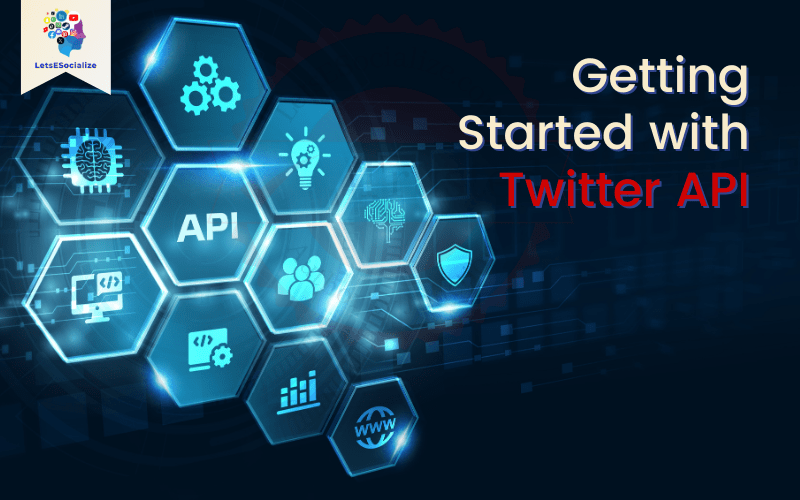The Twitter API allows developers to access and integrate Twitter data and functionality into their own applications. With the Twitter API, you can build apps that post, search, stream real-time tweets, and more.
In this comprehensive guide, we’ll cover everything you need to know to use the Twitter API as a developer.
Table of Contents
An Overview of the Twitter API
The Twitter API provides REST and streaming endpoints to access Twitter data. Some of the capabilities include:
- Posting, searching, and engaging with tweets
- Accessing profile info, followers, friends, favorites, etc.
- Real-time streaming of tweets
- Media manipulation and management
- Account management and user authentication
Different API endpoints are available based on the activity you want to perform. The main components of the Twitter API include:
- REST APIs: Allow basic CRUD (create, read, update, delete) operations on Twitter resources.
- Streaming APIs: Provide real-time access to tweets as they are posted.
- Ads API: For accessing advertising data and managing promoted tweets.
- Media API: For uploading and managing media like images and videos.
Some API request examples:
- GET statuses/user_timeline – Get recent tweets for a user
- POST statuses/update – Post a new tweet
- GET search/tweets – Search for tweets containing keywords
Getting API Access and Credentials
To start using the Twitter API, you need to first apply for developer access to get your API keys:
- Go to https://developer.twitter.com and log in with your Twitter account.
- Apply for a Twitter developer account. You’ll need to describe how you plan to use the API.
- Once approved, create a new app in the App Dashboard.
- Generate your Consumer Key, Consumer Secret, Access Token, and Access Token Secret.
- Test your keys by making a simple API request.
Save your API keys somewhere secure – they authenticate all your API requests.
Making Your First Request – GET Search Tweets
Let’s make your first Twitter API request to search for tweets! We’ll use the GET search/tweets endpoint.
- The endpoint is:
https://api.twitter.com/2/tweets/search/recent - Parameters to pass:
query– search keywordsmax_results– number of Tweets to return (max 100)tweet.fields– tweet attributes to includeexpansions– additional data like author_id and referenced_tweets.iduser.fields– user attributes to include- Headers:
Authorization– Pass your bearer token (generate from API keys)Content-type– application/json- Sample request:
GET https://api.twitter.com/2/tweets/search/recent?query=twitter%20api&max_results=10&tweet.fields=created_at&expansions=author_id&user.fields=created_at
Authorization: Bearer <your bearer token> This searches tweets containing “Twitter API” returns 10 results, with tweet creation date and author creation date as attributes.
Check the API reference docs for details on all the available parameters.
Search API Tips
- Use filters like
has:images,from:twitterdev, orlocation:San Franciscoto narrow search results. - The max number of tweets returned is 100 per request. Use pagination tokens to get further pages of results.
- Results are sorted by recent first by default. Use
sort:relevancyto sort by relevance instead. - RequiresElevatedAccess scope if searching last 7 days of tweets.
There are so many ways to customize searches using parameters like keywords, filters, attributes to include, etc. For more tips, refer to the Twitter advanced search docs.
Accessing the Full Tweet Object
The search API returns pretty limited info – tweet text and creation date. To get the full Tweet object:
- Use
expansions=attachments.media_keys,author_idto expand results. - Set
media.fields=url,preview_image_urlanduser.fields=name,username,profile_image_urlto get media and user attributes. - You can match the tweet to its expanded author and attachment objects.
This returns much richer info like the user’s profile image, name, and the tweet’s media.
See the expansions docs for more details on expanding objects.
Posting Tweets Programmatically
Posting tweets is simple with the API. The endpoint is:
Set the Authorization header with your bearer token, and pass the tweet text in the JSON body:
POST https://api.twitter.com/2/tweets
Authorization: Bearer <your bearer token>
{
"text": "Posting my first tweet using the Twitter API!"
}Users with academic research access can post original tweets. Other users can reply to existing tweets or retweet.
See the POST tweet docs for details on media uploads, quote tweets, etc.
Getting User Timelines
To programmatically get recent tweets for a user, use the GET user timeline endpoint:
Pass the user’s Twitter ID to the :id parameter. For example:
GET https://api.twitter.com/2/users/2244994945/tweetsReturns the user’s most recent tweets (by default last 10) and retweets.
You can pass exclude=retweets to leave out retweets, tweet.fields to limit attributes, and max_results up to 100.
See the GET user timeline docs for details.
Working with Tweet Media
The Twitter API provides a media API to upload images, GIFs, or videos to Twitter:
Upload the media file in a POST request – Twitter will prepare and process the media async.
The response will include a media_id to reference this media in your tweets.
- Set the
Authorizationheader with your bearer token. - Pass the media file in the request body.
- Set
Content-TypeandContent-Lengthheaders appropriately.
Once uploaded, pass the media_ids array when posting tweets to attach media:
POST statuses/update
{
"status": "Check out this cool photo!",
"media_ids": ["<uploaded media id>"]
}See the Twitter media docs for more details on media uploads.
Streaming API Overview
The streaming API provides real-time access to tweets. There are different streaming endpoints:
- Sample stream – random sample of ~1% of all tweets
- Filter stream – filtered tweets by keywords, users, locations etc.
Key use cases:
- Real-time analysis of tweets
- Alerting on keywords, spikes in volume
- Data collection, sentiment analysis
Connecting to the Sample Stream
The sample stream endpoint returns a random selection of public tweets:
- Set
Authorizationheader with bearer token - Set
Content-Typeheader toapplication/json - Connect & hold open the connection to stream tweets
It will continuously return tweets in JSON format – parse and process them in your app!
Use tweet objects directly or join with expansions/fields for rich info.
Filter Stream by Keywords, Users, Places
The filter stream allows filtering tweets in real-time by:
- Keywords or hashtag
- User IDs to track
- Location bounding boxes
Endpoint:
Pass tweet.fields and expansions parameters to get full tweet objects.
For example, this tracks tweets mentioning “api”:
GET https://api.twitter.com/2/tweets/search/stream
Authorization: Bearer <your bearer token>
{
"query": "(api) lang:en",
"tweet.fields": "created_at"
}See the Twitter filter stream docs for all the parameters.
The streaming API is powerful for real-time apps!
Analyzing Tweets with the Annotate API
The Annotate API provides advanced linguistic analysis on tweets. You can:
- Detect languages
- Analyze sentiment
- Classify content
This helps understand things like tweet popularity, virality, and impact.
Detect Languages
Many tweets are multilingual. The language detection endpoint identifies languages in a tweet:
Pass a tweet’s ID to analyze its language content. The response will include the detected languages, confidence scores, and most likely language.
This helps automatically sort tweets by language, translate, or detect trends.
Sentiment Analysis
Sentiment analysis classifies how positive or negative the sentiment of a tweet is:
{
"annotations": {
"sentiment": {
"enabled": true
}
}
}The response will return a sentiment object with positive, negative, and neutral sentiment scores.
This is useful for tracking brand sentiment, reviews, measuring campaign impact, etc.
Content Classification
You can classify tweets by topics, interests, and more.
Enable topics, interests, and entities in the annotate request body, like:
"annotations": {
"topics": {
"enabled": true
},
"interests": {
"enabled": true
},
"entities": {
"enabled": true
}
} The results give scores for relevance to topics, interests, and details on detected entities.
Learn more on Twitter’s Annotate API docs.
Accessing Trending Data
The trends API provides info on top trending topics and hashtags on Twitter. Endpoints:
GET trends/place– Trends by locationGET trends/available– Available locationsGET trends/close– Trends close to a geo-location
For example, top 10 US trends:
GET trends/place?id=23424977
{
"country": "United States",
"trends": [
{
"name": "#FirstWorldProblems",
"tweet_volume": 102933
},
...
]
} Trends are available for cities, countries, worldwide, etc. This powers many trend visualization apps.
Curated Events
The curated events endpoint returns events like sports games, TV shows, concerts, etc., that have lots of Tweets:
Pass event.fields=name,start_time,end_time,description to get event details.
Results are sorted chronologically, so it acts like an events calendar!
Academic Research Access
The Twitter API offers enhanced access to academic research:
- Access to full history for a sample of Tweet IDs
- More data from certain endpoints
- Ability to tweet from apps
Researchers can apply for access through Twitter’s developer portal.
Some features include:
GET /2/tweets/:id/history– Get all previous versions of a TweetGET /2/spaces/:id– Access to Spaces metadataGET /2/users/:id/mentions– See all mentions of a user
This access enables large-scale Twitter studies across disciplines like social science, politics, communication, etc.
Best Practices for the Twitter API
Here are some best practices to keep in mind when using the Twitter API:
- Rate limiting – Check the rate limits headers in responses and throttle requests if needed.
- Pagination – Many endpoints paginate results – use pagination tokens to collect all data.
- OAuth – Always use OAuth for authentication, and avoid sharing API keys.
- HTTPS – Make requests over HTTPS only for security.
- Caching – Implement caching and etags to avoid repeated requests.
- Asynchrony – Use queues, workers, and async I/O for efficient parallelization.
Additionally:
- Document your APIs with OpenAPI
- Handle errors and retries gracefully
- Follow Twitter’s API terms, privacy policies, and display requirements
This will lead to robust, production-ready API clients and apps!
Client Libraries for the Twitter API
It’s recommended to use an official Twitter API client library instead of calling the API directly:
Python – tweepy
Install via pip:
pip install tweepyTweepy provides a clean Python interface:
import tweepy
client = tweepy.Client(
consumer_key=...,
consumer_secret=...,
access_token=...,
access_token_secret=...
)
# Get tweets by user ID
user_tweets = client.get_users_tweets(id='2244994945')
# Post a tweet
client.create_tweet(text="Hello world!")JavaScript – twitter-api-v2
npm install twitter-api-v2const { TwitterApi } = require('twitter-api-v2');
const client = new TwitterApi({
appKey: ...,
appSecret: ...,
accessToken: ...,
accessSecret: ...,
});
// Search tweets
const search = await client.v2.search('twitter api');
// Post a tweet
const tweet = await client.v2.tweet('Hello world!'); In popular languages, see GitHub for other Twitter API libraries.
Tools for Testing the API
Some useful tools for testing the Twitter API:
- Postman – Send API requests and test responses
- Insomnia – Feature-rich API client for testing
- Paw – API tool to build and debug requests
- jq – JSON processor for transforming responses
- Dart HTTP – no nonsense HTTP client from Dart
- HTTPie – Command line HTTP client, great for quick tests
These make it easy to explore endpoints, inspect responses, and build proof of concepts without writing much code.
Common API Use Cases
Some common use cases for the Twitter API:
Social Listening & Analytics
- Track brand/product mentions
- Monitor hashtags, events, campaigns
- Sentiment analysis
- Trend analysis
- Measure reach and engagement
Research & Data Mining
- Gather data for machine learning datasets
- Network/graph analysis of users, interactions
- Text analysis for NLP research
- Study information diffusion patterns
Engagement Automation
- Auto-reply to mentions and DMs
- Follow/unfollow users
- Create auto-tweets based on triggers
- Schedule tweets and post at optimal times
Chatbots & Conversational AI
- Reply to tweets and DMs
- Post automated tweets reactively
- Implement Twitter conversation workflow
- Integrate with dialogue systems
Tweet Aggregators
- Discover and curate posts on topics
- Create embeddable “walls” of tweets
- Allow filtering, searching, organizing tweets
This is just a small sampling – there are endless possibilities for building on the Twitter platform!
Compliance, Ethics, and Responsible Use
When tapping into Twitter’s data, it’s important to follow ethical guidelines:
- Respect user privacy – Mask usernames in public datasets, delete tweets after analysis and minimize data retention.
- Follow terms of use – Stay compliant with Twitter’s API terms and restrictions.
- Add value – Build apps that improve Twitter and enhance the user experience.
- Attribute data – Credit Twitter data appropriately in publications and analyses.
- Transparency – Disclose identity and usage purposes and get informed consent where applicable.
Integrating Twitter with Other Platforms
The Twitter API enables integrating tweets and data into other platforms:
Websites & Blogs
- Display tweets by topic dynamically
- Embed live-updating Tweet streams
- Show top hashtags and trends about your site
- Enable users to share pages easily
Mobile & Desktop Apps
- Add Twitter login, tweet sharing in apps
- Create Twitter clients for different devices
- Build companion apps for Twitter power users
- Sync Twitter user data and relationships
Business Intelligence & Dashboards
- Visualize Twitter metrics and KPIs
- Monitor brand sentiment over time
- Analyze tweet geography, demographics, interests
- Identify influencers and optimize targeting
Marketing Automation
- Trigger emails, push notifications on events
- Create customer journeys based on interactions
- Automate cross-channel campaigns across Twitter, email, etc.
- Generate lead list for sales based on engagement
With a little creativity, the possibilities for integrating with Twitter data are endless!
Common Challenges and Solutions
Here are some common challenges developers face with the Twitter API and potential solutions:
Rate Limiting
Twitter’s API is rate limited to control traffic. Avoid hitting the limit by:
- Checking the rate limit headers and pacing requests
- Using a retry-after delay if provided in headers
- Caching requests where possible – avoid repeat calls
- Queueing requests and spreading over time
- Trying a lower volume endpoint if available
Data Limits
Endpoints like search tweets return a limited number of results. To collect more data:
- Use multiple requests with pagination tokens
- Switch to the premium full-archive search endpoint
- Use the streaming API, if possible, for unbounded data
Authentication issues
- Make sure to use OAuth 1.0a user context authentication
- Verify credentials are correct
- Check token expiration and refresh if needed
Deprecated endpoints
Twitter is constantly evolving its APIs and deprecating old ones. When endpoints get removed:
- Find a replacement endpoint from the docs
- Test it out in a sandbox first before migrating
- Notify users of your app if breaking changes occur
Proper error handling, logging, and monitoring help quickly diagnose and debug other issues when they arise.
Best Practices for Working With Tweet Data
When working with Twitter data in your applications, keep in mind some best practices:
- Be transparent in disclosing the identity and usage of the data
- Respect user privacy – minimize retention periods, anonymize usernames
- Validate data – check for fake or biased tweets
- Handle personal/sensitive data ethically per terms of use
- Attribute Twitter as source of data in publications
- Clarify the context of tweets – they are brief, unedited snippets
- Consider biases – trends may not represent the overall population
- Follow Twitter’s requirements for displaying tweets
- Report security issues or toxic/illegal behavior appropriately
Working closely with Twitter’s API policies and guidelines creates more positive ecosystems for developers, researchers, and tweeters alike!
Twitter API Roadmap
Twitter is improving its API products with new releases every 1-2 weeks. Some upcoming items on their roadmap include:
Spaces API Updates
The Spaces audio chat API is still in beta. Planned improvements:
- Access to more metadata like scheduled Spaces, hosts
- Ability to retrieve Space replays
- Streaming support for live Spaces
Expanded Tweet Objects
The Tweet object will include additional metadata like:
- Post engagement data – impressions, likes, retweets
- Related media – cover images, linked videos
- Referenced tweets – parent tweet in threads, quoted tweets
- Entity extraction – people, places, and organizations mentioned
Advanced Metrics Endpoint
A new endpoint is planned for aggregating metrics like:
- Tweet/follower counts over time
- Engagement stats for tweets, profiles
- Audience insights like top interests and locations
Enhanced Filter Capabilities
More ways to filter streams and search endpoints by:
- Author ID ranges (find new/inactive users)
- Granular geo regions, languages, user attributes
- Machine learning classifiers (text, spam, nudity)
- Tweet engagement thresholds
Stay tuned to their developer changelog for the latest!
Resources for Learning the Twitter API
Here are great resources to continue learning about the Twitter API:
- Twitter API Reference Docs – Official API docs
- Twitter Developer Community – Discuss with other devs
- Building with Twitter Threads – Demos and tips from experts
- Twitter API Videos – Video walkthroughs of concepts
- Twitter Dev Webinars – Workshops and office hours
- Awesome Twitter Data – Tools & resources for mining tweets
The official docs are the most comprehensive resource. For help, check out Stack Overflow and the #TwitterDev hashtag.
The Twitter API opens up so many creative possibilities – have fun building!







